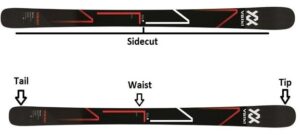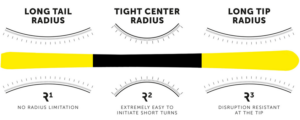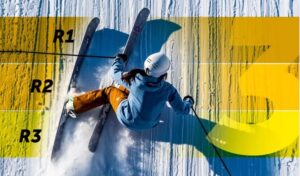by Mike Whitaker
Confused by the recent introduction of multi-radius wizardry? You’re not alone. Start asking questions and you’ll quickly get a variety of differing views. To get a good handle on what this new buzz can do for us, it’s important to understand the design characteristics that make a ski turn. At the forefront is a ski’s sidecut. Sidecut refers to the way the right and left side of the ski are shaped. It’s the hourglass curvature we see when the ski is lying flat on the ground.
Sidecut determines the type of the turn the ski is designed to make and that lets us know in what conditions the ski likely performs best. Sidecut is measured in millimeters (mm). These dimensions are generally printed on the ski in the following format: 132-84-120. The first number represents the tip width. The second is the waist(underfoot), and the third is the tail.
The difference between the widest points (tip and tail) of a ski and the narrowest (waist) tell us how the ski will turn. Skis with a large differential will make tight turns, such as when a ski’s dimensions are 134-84-120 there is a 50mm difference between the tip and the waist. Skis like this are known as short radius. Skis with a lesser differential like 134-104-120 make longer turns, and these skis are known as long radius. The greater the differential from tip and tail towards the waist the tighter it will turn and vice versa.
Click here to see how sidecut helps us turn.
Ski length is a critical variable in relation to sidecut. Manufacturers generally do not alter dimensions for different lengths. Short lengths have greater curvature (deeper sidecut) and will turn tighter than longer lengths where the sidecut is elongated by lengthening the ski. Therefore, a ski in one length will perform differently than the same ski in another length, sometimes distinctly differently.
Sidecut also plays into stability. Long radius sidecuts (elongated curvatures) offer more stability, especially when the ski is running flat (straight) and in conditions like powder, chop, or crud. This comes with a caveat. While longer radius sidecuts initiate and exit turns more smoothly, offering more stability, they make wide sweeping turns and gain speed quickly. Short radius sidecuts deliver quicker, tighter turns and better manage speed control. However, they are often quirky, squirrely, and harder to control when running flat, in powder conditions, or crud.
There’s another reality to how a ski turns. The turning character that we experience when we swoosh down the piste is additionally ruled by the terrain and our ability.
Skier ability is a biggie. Applying the right angulation, pressure, and rotation to get the desired turn while maintaining control and confidence is historically learned from countless hours of experience. But the masses of skiers don’t have countless hours to learn this. Nor do they desire to own a quiver of short and long radius skis to tackle each specific terrain condition they may encounter. And why do they have to if technology can step in, aiding things along and making the whole skiing experience more enjoyable?
The quest of ski brands is to produce a ski that performs across a variety of terrain and conditions while being able to serve varying degrees of ability. The latest piece of this puzzle lies within a new trend in sidecut technology. These skis have multiple radius values printed on their topsheets, generally three, and now even four.
Blending multiple radii into a ski’s sidecut is nothing new. As the first carving skis hit the snow in the 1990s, it was quickly discovered that the new hourglass design could be taxing outside of groomed trails. Even on groomed runs some of these skis proved difficult to release out of a turn. Designers countered by altering sidecut curvature.
Still most skis remained focused upon a single turn radius for a long time. We increased edge angle and pressure while adding more rotation when we wanted to turn tighter than the intended radius. Making a short turner like a slalom cut go long takes some finesse, as these skis need to be feathered. All of this requires refined technique. With the onset of rocker technology, ski designers began to get creative and start mixing things up. We quickly learned that a one act show just isn’t as fun, nor does it have the versatility.
Sidecut is taking a leap forward with multi-radius applications. This evolutionary technology is looking at how sidecut can better relate to camber, rocker, pressure, and flex to create fun, confidence, and control in relation to terrain and ability.
What we get is a more easily attainable variety of turn sizes and shapes combined with enhanced stability and control. When the ski is running flat or slightly on edge it is running on the longer tip and tail sidecuts yielding confident stability, easy turn initiation and exit, and smooth sweeping turns.
As we tip into higher edge angles and naturally build pressure at the center of the ski, the long radius sidecuts give way to the midsection (waist) short radius where tighter turning is accessed. And voila, we’re ripping beautiful tight carves on the same ski.
Moving into the next turn, the midsection radius eases back into the benefits of the longer radius tip and tail. This all happens rather intuitively and is smoothly unnoticeable. Overall, the ski is very predictable and offers a wider variety of performance over traditional sidecut technology.
There’s a host of wins happening here. Short radius sidecuts require less effort to maneuver and react faster. The ski becomes more responsive and agile when the midsection radius is engaged. The resulting shorter, quicker turns are helpful with speed control and in tight spaces like trees and narrow runs.
Maneuverability is key in moguls. But a short radius carver can be tricky. Meshing a long radius sidecut into the tip eases turn initiation and inhibits the ski from hooking into a deep carve, throwing us off balance and racing out of our intended path. Tossing-in an elongated tail radius makes it easier for everyone to release into the next turn and it helps stabilize the ski while doing so.
Zipping through pristine powder among legendary back bowls favors long sweeping stable turns. So does the chop and crud that follows. The path of enjoyment in these types of terrain and conditions are not high edge angles and tight turns. It’s a more direct path of shallower edge angles that engages the smooth and steadfast tip and tail radiuses. Limiting edge angle to these same long radius sidecuts on groomed or packed surfaces serves up confident edge grip and energy transfer for dynamic GS turns and higher speeds. And should you find yourself in imminent need or just be in the hanker for a quick turn, all you have to do is tip to engage the underfoot. Multi-radius sidecuts literally conform on demand.
The sidecut combination is generally short radius in the midsection with longer radiuses in the tip and tail. The blending of multi-radius sidecuts is the result of a long progression of trial and error and they haven’t always worked so well. A few skis are the opposite with long in the midsection and shorter in the tip and tail. These are mostly powder oriented freeriders and they can be hooky.
Three radius technology has been an effective integration for the past few years on skis from brands such as Volkl, Atomic, and Fischer. A four sidecut technology is now being introduced. The idea is to tighten up the sidecut transitions for quicker tip engagement at higher edge angles for more aggressive skiers without compromising versatility and ease of handling, and it works. Volkl’s new 4D Radius Drive delivers a ski with noticeably more performance for seasoned skiers without diminishing approachability or efficiency to advancing riders. You’ll find Volkl’s sidecut wizardry on the new Mantra M7, the Secret 96, the new Blaze 104, and the Blaze 94 for the 2024-2025 model year.
Volkl and others like them are onto something. What a vast majority of skiers seek is a do-it-all ski. They’re looking for one that they can hop on and feel confident on the first day of their vacation, one that will (within reason) take them from the groomers to the powder and everything in between, and one that will stay with them as they progress. There’s a golden ticket in developing skis that do a lot of things well across a variety of terrain and conditions and that cater to a broad swath of ability all in one package.
Keep in mind that multi-radius sidecut alone does not achieve the level of performance we’re speaking of here; that it happens in conjunction with a finely tuned coalescence of flex, camber, and rocker. It’s the whole package that achieves this level of performance. And there are skis in the marketplace that employ similar sidecut technology that are not branded as multi-radius, but I suspect some soon will be.
Confident control across the spectrum of terrain and conditions once required a plethora of refined techniques in angulation, pressure, steering, and body positioning. And it took a quiver of skis. That’s just not the case any longer. Ever evolving ski technology is doing a ton for us and sidecut is a critical element. Multi-radius helps us superiorly tackle more of the mountain and the various terrain conditions that come along. Don’t hesitate to give the new multi-radius boards a spin. They’re fun, approachable to a range of abilities, and deliver a lot of performance.








